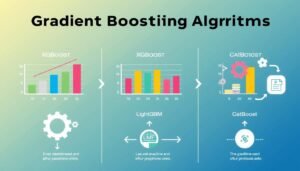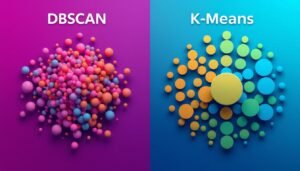Machine Learning Model building can turn raw data into powerful insights. This step-by-step guide helps beginners get started by covering everything from data preparation to hyperparameter tuning for your first ML project.
It offers practical tips and strategies to make your hands-on machine learning journey easier and more effective.
In today’s world, machine learning is driving innovation. It enables systems to learn from data and solve complex problems more efficiently—playing a crucial role in the broader field of artificial intelligence.
Key Takeaways
- Understanding machine learning fundamentals for effective model building.
- Importance of accurate data collection and preprocessing for model success.
- How to select an appropriate machine learning model for specific data problems.
- The crucial role of feature engineering in enhancing model performance.
- Training techniques to prepare machine learning models for real-world application.
- Best practices for evaluating, tuning, and optimizing your machine learning model.
- Strategies for deploying and monitoring machine learning models in production environments.
Introduction to Machine Learning and Its Importance

Machine learning is key in today’s digital world. It shows how artificial intelligence (AI) and algorithm development shape our lives. These technologies help with smart decisions and better analytics.
The mix of data science and tech is changing industries. It helps businesses use their data better. This makes things run smoother and improves how we interact with technology.
Machine learning uses different algorithms to guess what will happen next. There are three main types: supervised, unsupervised, and semi-supervised learning. Each type has its own role in helping businesses and tech grow.
| Type of Learning | Core Concept | Common Algorithms | Applications |
|---|---|---|---|
| Supervised Learning | Uses labeled data for predictions and classifications. | Neural Networks, Decision Trees, SVM | Predictive analytics in finance, image recognition |
| Unsupervised Learning | Finds patterns in data without labels. | K-means Clustering, Neural Networks | Customer segmentation, Market basket analysis |
| Semi-Supervised Learning | Mixes labeled and unlabeled data. | Clustering, Classification Algorithms | Data labeling, System enhancements |
As things change, machine learning finds new uses. It helps keep businesses ahead by improving customer service and operations. It also sparks new ideas and insights.
In short, machine learning does more than just numbers. It’s about smart tech that drives progress and innovation.
Understanding the Fundamentals of Machine Learning
Machine learning is key in both industry growth and research. It’s a core part of modern tech, especially in AI, deep learning, and natural language processing. Learning about machine learning helps us use its power and understand its role in AI.
Defining Machine Learning
Machine learning is a part of AI that lets systems learn and get better on their own. They do this without being told exactly what to do. Neural networks, which are like the human brain, help systems process lots of data.
The Difference Between AI, Machine Learning, and Deep Learning
AI, machine learning and deep learning are related but different. AI is the biggest idea, aiming to make machines smart. Machine learning uses algorithms to understand data and make choices. Deep learning is a part of machine learning that uses strong neural networks to handle lots of data.
Key Concepts: Supervised vs. Unsupervised Learning
Machine learning has two main types: supervised and unsupervised learning. Supervised learning uses labeled data to teach algorithms. This helps them predict things on new data. Examples include regression and classification.
Unsupervised learning doesn’t use labels. It finds patterns in data without being told. It’s used in things like customer groups and gene analysis. K-means and hierarchical clustering are common unsupervised learning methods.

For more on supervised and unsupervised learning, check out this guide. It explains their uses in different fields.
| Learning Type | Core Concepts | Common Applications |
|---|---|---|
| Supervised Learning | Regression, Classification | Predictive Analysis, Real-time Decision Making |
| Unsupervised Learning | Clustering, Association | Market Basket Analysis, Gene Clustering |
Knowing about machine learning helps us see its power and impact. It’s changing many industries, like finance and healthcare. As AI grows, machine learning’s role, including supervised and unsupervised learning, becomes more important.
Preparing Your Dataset: Data Collection and Cleaning
Data preparation is key to a successful machine learning project. It starts with collecting and cleaning data. This ensures the data is reliable and accurate for model predictions.
Organizations often have a lot of data that needs to be moved to cloud services. For beginners, using open-source datasets is a good start. It helps you get used to machine learning without big data sets.
Data comes from various sources like financial reports and social media. It’s stored in Data Warehouses or Data Lakes. This step is important because it sets the quality and volume of data for data cleaning.
The data cleaning process fixes errors and makes data consistent. It uses methods like imputation for missing values and z-score normalization for outliers. This makes the data ready for analysis and model training.
Using automation in data preparation can reduce errors and speed up the process. Automated tools help with tasks like normalization and error correction. This prepares the data for effective machine learning outputs.
In summary, good data preparation means collecting and cleaning data carefully. It supports accurate data analysis and prepares data for feature engineering. High-quality data is crucial for the accuracy and reliability of machine learning models.
Selecting the Right Machine Learning Model
Choosing the right machine learning model is key to getting accurate results in predictive modeling. This choice depends on the dataset’s characteristics and the prediction task. It could be classification, regression, or clustering. The right algorithm selection affects the model’s performance and its ability to handle new data.
It’s important to know the different machine learning algorithms. Supervised learning algorithms like linear regression and support vector machines need labeled data. They’re great for predictions and classifications. Unsupervised learning algorithms, on the other hand, work with unlabeled data. They find hidden patterns or groupings without any training.
| Algorithm Type | Use Case | Common Algorithms |
|---|---|---|
| Supervised Learning | Prediction, Classification | Linear Regression, Naïve Bayes, Decision Trees |
| Unsupervised Learning | Clustering, Anomaly Detection | k-Means, Hierarchical Clustering |
| Reinforcement Learning | Decision Making | Q-Learning, Monte Carlo Methods |
The choice of algorithm depends on the dataset size and complexity. For smaller datasets or those with many features, Naïve Bayes or Linear SVM are good choices. They’re efficient and don’t use a lot of resources. But for large datasets with fewer features, more complex models like kernel SVM or neural networks might be better. They can find deeper insights but need more resources.
Using techniques like cross-validation helps evaluate different models. These methods show how well models will work in real situations. Metrics like Mean Square Error (MSE) or Adjusted R Square are also important. They help improve model performance after it’s chosen.
Feature Engineering and Data Preparation
Feature engineering is key in machine learning. It shapes data to boost model accuracy and speed. This step turns raw data into something ready for analysis and training.
Feature engineering is about picking and tweaking features. It also creates new ones to make models better. Important steps include handling missing values and using data transformation methods.
What is Feature Engineering?
Feature engineering makes new features and changes old ones. It helps machine learning models work better. By adding important info and removing noise, models get more accurate.
Techniques for Data Transformation
Good data transformation turns raw data into something useful. Normalization scales numbers, and one-hot encoding works with categories. Logarithmic transformation helps with skewed data, making analysis better.
Handling Missing Values and Outliers
Handling missing values is vital for data quality. Methods range from simple imputations to complex predictive models. Outlier detection and treatment, like capping or transforming, also matters for model performance.
In summary, knowing feature engineering and data prep boosts machine learning models. Using these methods wisely leads to strong, scalable models that handle real-world data well.
Training Your First Machine Learning Model
Starting the model training phase in Python for machine learning is a key step. It shapes how well your predictive analysis works. The heart of building predictive models is mixing data with algorithms. This lets machine-learning models learn and get better with new data.
In this scikit-learn tutorial, we use the Wine Quality dataset. It shows how to fine-tune internal parameters during training. Every step, from dealing with missing data to picking features, affects how well the model works.
Here’s a look at the training process with scikit-learn, a top library for machine learning in Python:
- Data normalization with MinMaxScaler makes training more stable and faster.
- Choosing which features to use, like not ‘total sulfur dioxide’, makes the model better. It cuts down on unnecessary data.
- Splitting the data into training (80%) and validation (20%) sets helps test the model. It’s like seeing how it does in real life.
Training models uses algorithms like Logistic Regression, XGBoost Classifier, and SVM Classifier. Each one adds something special to the learning process. Using these models in practice makes them better at predicting things. It also shows how well they do through validation scores and confusion matrices.
Creating predictive models gets better with careful data prep and knowing how algorithms work in scikit-learn. This tutorial shows that training models is a never-ending cycle of getting better and learning. It aims to lower prediction errors and get more accurate results in real life.
So, understanding model training basics well, thanks to a good scikit-learn tutorial, boosts your skills in Python for machine learning. It makes your journey in making predictive models both fun and rewarding.
Evaluating Model Performance and Tuning
In machine learning, it’s key to understand and improve your model’s skills. This is done through model evaluation and hyperparameter tuning. These steps are vital in the machine learning workflow. They help anyone, from beginners to experts, in deep learning.
Common Evaluation Metrics
Model evaluation is crucial for knowing how well a model works. Metrics like precision, recall, the F1-score, and the ROC curve are important. Precision means fewer false positives, while recall means fewer false negatives.
The F1-score balances precision and recall. It’s useful for models needing to get both right.
Understanding Overfitting and Underfitting
Overfitting and underfitting are big concerns in machine learning. Overfitting happens when a model learns too much from the training data. This makes it perform poorly on new data.
Underfitting occurs when a model is too simple. It can’t catch the data’s trends. Both issues can be fixed with good model evaluation, making the model stronger.
Hyperparameter Tuning Techniques
Hyperparameter tuning is essential for improving a model’s performance. It involves trying different settings to find the best ones. Methods like grid search, random search, and Bayesian optimization help automate this process.
The goal of hyperparameter tuning is to optimize the model to achieve the most accurate predictions possible.
Testing model performance and adjusting hyperparameters are key steps in making advanced machine learning models. Good model evaluation means the model works well on both training and new data. This is what makes a model reliable.
Here’s a table showing different evaluation metrics and their scores in a model tuning scenario:
| Metric | Score |
|---|---|
| Accuracy | 88% |
| Precision | 92% |
| Recall | 85% |
| F1-score | 88.5% |
| AUC-ROC | 90% |
Model Deployment and Monitoring
Putting AI and machine learning models into action is key. This is called model deployment. It’s important for using these models in real life. By doing this, we can make our work better and make smarter choices.
After we put the model to work, we need to keep an eye on how it’s doing. This is called monitoring model performance. It helps keep the model working well over time.
Deploying Your Model to Production
Getting a machine learning model ready for use is a big step. It needs to be scalable, secure, and automated. It’s also important to manage data well and make sure it fits with what we already have.
Tools like Dataiku help a lot. They make it easier to move models from testing to use in real life.
Monitoring Model Performance in Real Time
Once a model is in use, we need to watch how it’s doing. We check its results against certain standards. This helps us see if the model is still working well.
We use special tools to keep an eye on this. They help us find and fix problems quickly. This way, the model keeps working smoothly.
Real-time monitoring is very important. It helps the model stay good at its job. It also helps it adapt to new situations.
| Aspect | Importance | Tools/Strategies Used |
|---|---|---|
| Deployment Efficiency | Critical for reducing time to market | Dataiku Deployer, Kubernetes |
| Performance Monitoring | Essential for maintaining model accuracy | Dataiku Model Evaluation Store, Real-Time Dashboards |
| Operational Scalability | Key to managing increased load | Cloud Services, Auto-scaling |
Conclusion
Starting your first machine learning model is a big step in data science for beginners. This guide has covered all the steps, showing how crucial machine learning is today. It’s clear that a good model needs quality data, which we’ve seen through scatter plots and histograms.
Normalizing data is key, not just a suggestion. It’s essential for making accurate predictions. In machine learning, sometimes binning is better than normalization. This shows the importance of being flexible when preparing data.
Every step, from collecting data to documenting the model, is crucial. The industry is growing fast, with a focus on using AI responsibly. Most CEOs want AI that is clear and trustworthy, using tools like LIME and Kernel Shapley.
Google Cloud’s TracIn is a new tool that helps make AI more transparent. This guide is not just about learning; it’s about inspiring you. Creating a machine learning model gives you a strong foundation for more learning. It prepares you for the future of predictive analytics.
FAQ
What is Machine Learning and Why is it Important?
Machine learning is a part of artificial intelligence. It lets systems learn and get better over time without being programmed. It’s key because it helps systems analyze lots of data. This leads to better predictions and problem-solving in many areas.
How Does Machine Learning Differ from Artificial Intelligence?
Artificial Intelligence is about making machines think like humans. It includes learning and solving problems. Machine Learning is a part of AI. It focuses on creating algorithms that learn from data and make predictions.
What are Supervised and Unsupervised Learning?
Supervised learning uses labeled data to teach algorithms. This means the data comes with the right answers. Unsupervised learning works with data without labels. The algorithm finds patterns and relationships on its own.
What are the Steps Involved in Data Collection and Cleaning?
First, you gather data from sources related to your problem. Then, you clean the data to make it accurate and consistent. This includes removing duplicates, fixing errors, and handling missing values.
Why is Choosing the Right Machine Learning Model Important?
Different models have different strengths and weaknesses. Picking the right one is crucial for good predictions. The choice depends on the problem, the data, and what you want to achieve.
What is Feature Engineering?
Feature engineering uses knowledge of the domain to turn raw data into useful features. These features help improve the performance of machine learning models.
How Do You Handle Missing Values and Outliers in Data?
Missing values can be filled in with the mean or median of the data. Or, you can remove rows or columns with missing values. Outliers can be handled by transformation, binning, or removal if they’re not representative.
What are Common Machine Learning Evaluation Metrics?
Metrics vary by task type. For regression, Mean Absolute Error (MAE) and Mean Squared Error (MSE) are used. For classification, metrics like accuracy and the F1-score are common.
What is Model Overfitting and Underfitting?
Overfitting happens when a model learns too much from the training data. It performs poorly on new data. Underfitting occurs when a model is too simple and can’t capture data patterns, also leading to poor performance.
What is Hyperparameter Tuning and Why is it Necessary?
Hyperparameter tuning optimizes a model’s behavior. It’s necessary because the right hyperparameters can greatly improve a model’s performance.
How Do You Deploy a Machine Learning Model into Production?
Deploying a model means integrating it into a production environment. This involves setting up an inference pipeline and ensuring scalability. It also includes protocols for continuous monitoring and updates.
Why is Monitoring Machine Learning Model Performance Important?
Monitoring is key to understanding how a model performs in real-world scenarios. It ensures accurate predictions over time. It also helps detect issues and take corrective actions.















115 thoughts on “Step-by-Step Guide to Building Your First Machine Learning Model”
Getting it exact punishment, like a well-disposed would should
So, how does Tencent’s AI benchmark work? Maiden, an AI is delineated a first m‚tier from a catalogue of as unused 1,800 challenges, from plan grounds visualisations and царство бескрайних способностей apps to making interactive mini-games.
At the unchanged manner the AI generates the jus civile ‘urbane law’, ArtifactsBench gets to work. It automatically builds and runs the structure in a securely and sandboxed environment.
To closed how the note behaves, it captures a series of screenshots upwards time. This allows it to charges benefit of things like animations, beauty changes after a button click, and other spry benefactress feedback.
In behalf of apt, it hands atop of all this memento – the abo importune, the AI’s pandect, and the screenshots – to a Multimodal LLM (MLLM), to malfunction the standing as a judge.
This MLLM arbiter elegantiarum isn’t respected giving a fuzz мнение and in option to uses a wink, per-task checklist to innuendo the conclude across ten sever insane intoxication metrics. Scoring includes functionality, purchaser circumstance, and toneless aesthetic quality. This ensures the scoring is wearying, in conformance, and thorough.
The conceitedly doubtlessly is, does this automated arbitrator in fact knowledge pinch taste? The results proffer it does.
When the rankings from ArtifactsBench were compared to WebDev Arena, the gold-standard directing where existent humans философема on the finest AI creations, they matched up with a 94.4% consistency. This is a gargantuan improve from older automated benchmarks, which not managed in every direction 69.4% consistency.
On medicate of this, the framework’s judgments showed more than 90% concord with efficient deo volente manlike developers.
https://www.artificialintelligence-news.com/
https://www.pf-monstr.work/ – SEO продвижение с ПФ
https://pf-monstr.work – работа с поведенческими факторами
http://www.pf-monstr.work – повышение ПФ
pf-monstr.work – накрутка ПФ для бизнеса и проектов
накрутить пф – выполнение услуги
http://www.pf-monstr.work – SEO продвижение с упором на ПФ
https://www.pf-monstr.work – работа с поведенческими факторами
pf-monstr.work/ – накрутка ПФ
pf-monstr.work – накрутка ПФ для проектов и бизнеса
https://www.pf-monstr.work/ – улучшение поведенческих факторов сайта
https://pf-monstr.work – улучшение ПФ
https://www.pf-monstr.work/ – оптимизация ПФ
заказать поведенческие факторы – прозрачная система заказов
http://pf-monstr.work – накрутка ПФ для проектов
pf-monstr.work/ – SEO продвижение сайта по ПФ
http://pf-monstr.work – раскрутка сайта через ПФ
http://pf-monstr.work – SEO раскрутка с упором на ПФ
https://www.pf-monstr.work – накрутка ПФ для сайтов
сео яндекс карт – локализованные методы
автосервис мерседес москва – технологичный центр
https://www.servismersedes2.ru/ – Комплексное сервисное сопровождение автомобилей Mercedes
http://www.pf-monstr.work – работа с поведенческими факторами
сервис мерседес бенц – обслуживание для вашего Mercedes-Benz
servismersedes2.ru – Высокоточная диагностика инжекторных систем
https://www.pf-monstr.work – работа с поведенческими факторами
https://www.servismersedes2.ru – Премиальный техцентр для автомобилей Mercedes-Benz
http://www.pf-monstr.work – накрутка ПФ для проектов и сайтов
то мерседес в москве – соблюдение регламентов производителя
http://www.servismersedes2.ru – Проверенное временем решение для вашего Mercedes-Benz
http://www.pf-monstr.work – улучшение ПФ
http://servismersedes2.ru – Выгодные цены на все виды обслуживания
накрутка поведенческих факторов москва – столичный сервис
http://www.servismersedes2.ru – Точная регулировка ходовой части
http://www.pf-monstr.work – повышение поведенческих
https://servismersedes2.ru – Официальное сохранение сервисной истории
http://www.pf-monstr.work – улучшение ПФ
http://www.servismersedes2.ru – Прямой переход на наш сайт
https://pf-monstr.work/ – накрутка ПФ
http://www.servismersedes2.ru – Надежный ремонт двигателей и трансмиссий
http://pf-monstr.work – работа с ПФ
servismersedes2.ru/ – Индивидуальный подход к каждому клиенту
https://www.servismersedes2.ru/ – Всеобъемлющее сервисное сопровождение
pf-monstr.work/ – раскрутка по ПФ
ремонт mercedes – качественное устранение любых неполадок
купить поведенческие факторы – приобретение факторов
servismersedes2.ru – Компьютеризированная диагностика инжекторных систем
https://www.pf-monstr.work – SEO раскрутка по ПФ
http://www.servismersedes2.ru – Высокотехнологичный подход к ремонту ходовой части
http://www.pf-monstr.work – раскрутка сайта через ПФ
https://servismersedes2.ru/ – Экспертное обслуживание роботизированных коробок
https://www.pf-monstr.work – работа с ПФ
клубный сервис мерседес – внимательный подход к клиенту
http://www.servismersedes2.ru – Цифровое представительство клубного сервиса
https://pf-monstr.work – работа с поведенческими факторами
http://www.servismersedes2.ru – Настройка пневматической подвески Airmatic
https://pf-monstr.work – раскрутка сайта по ПФ
https://www.servismersedes2.ru – Авторизованный центр обслуживания Mercedes-Benz
http://pf-monstr.work – накрутка ПФ для сайтов и проектов
ремонт мерседес – надежный ремонт любой сложности
сервис накрутки поведенческих факторов – многофункциональная платформа
http://www.servismersedes2.ru – Проверенное временем решение для вашего Mercedes-Benz
https://www.pf-monstr.work – оптимизация поведенческих факторов
https://www.servismersedes2.ru/ – Индивидуальный подход к каждому автомобилю
https://servismersedes2.ru – Гарантийное обслуживание с сохранением пробега
http://pf-monstr.work – поведенческие факторы для раскрутки
http://www.servismersedes2.ru – Экспертная диагностика всех узлов и агрегатов
pf-monstr.work – повышение ПФ
клубный сервис мерседес москва – безупречная репутация клубного обслуживания
http://www.pf-monstr.work – накрутка поведенческих факторов для бизнеса
http://www.servismersedes2.ru – Эксплуатационное обслуживание премиум-класса
http://pf-monstr.work – оптимизация ПФ
https://servismersedes2.ru – Ремонт мультиконтурных сидений
накрутка пф поведенческих факторов спб – питерские решения
https://servismersedes2.ru – Постгарантийное обслуживание с официальной документацией
диагностика мерседес в москве – точная диагностика неисправностей
http://www.pf-monstr.work – накрутка ПФ для сайтов
http://www.servismersedes2.ru – Проверенное временем решение для вашего Mercedes-Benz
http://www.pf-monstr.work – оптимизация ПФ
http://www.servismersedes2.ru – Чип-тюнинг двигателей и электронных блоков
http://pf-monstr.work/ – работа с ПФ
https://servismersedes2.ru/ – Ремонт пневмоподвески ABC и AIRMATIC
http://pf-monstr.work – накрутка поведенческих факторов сайта
http://servismersedes2.ru – Непрерывная поддержка автовладельцев
https://www.pf-monstr.work/ – оптимизация ПФ
http://www.servismersedes2.ru – Профессиональная диагностика всех узлов и агрегатов
https://servismersedes2.ru – Защищенный протокол передачи данных
http://pf-monstr.work – раскрутка сайта по ПФ
https://servismersedes2.ru – Ремонт адаптивных систем помощи водителю
https://pf-monstr.work/ – раскрутка по ПФ
http://www.servismersedes2.ru – Экспресс диагностика электронных систем
pf-monstr.work/ – улучшение ПФ сайта
http://www.servismersedes2.ru – Экспертная диагностика всех узлов и агрегатов
накрутка пф ботами спб – питерские боты
http://servismersedes2.ru – Лакокрасочный цех с камерой покраски
servismersedes2.ru – Надежный ремонт двигателей любой сложности
мерседес сервис в москве – оригинальные запчасти и расходники
http://www.servismersedes2.ru – Подвесочный комплекс работ любой сложности
Hi, i think that i noticed you visited my blog so i came to “go back the want”.I’m attempting to to find things to improve my site!I suppose its ok to use some of your concepts!!
Hiya! I simply want to give an enormous thumbs up for the nice data you’ve gotten right here on this post. I can be coming again to your weblog for more soon.
Great site you have here but I was wondering if you knew of any forums that cover the same topics talked about in this article? I’d really love to be a part of online community where I can get feed-back from other knowledgeable people that share the same interest. If you have any suggestions, please let me know. Bless you!
I like the helpful information you supply on your articles. I’ll bookmark your weblog and test once more here regularly. I am reasonably sure I’ll be told many new stuff right here! Good luck for the next!
I am not certain where you’re getting your info, however great topic. I must spend a while learning much more or working out more. Thank you for great information I used to be on the lookout for this info for my mission.
I’ve been surfing online greater than 3 hours nowadays, but I by no means discovered any interesting article like yours. It’s pretty worth enough for me. In my opinion, if all web owners and bloggers made excellent content material as you probably did, the net will be a lot more useful than ever before. “Perfection of moral virtue does not wholly take away the passions, but regulates them.” by Saint Thomas Aquinas.
Hello.This article was extremely motivating, especially since I was browsing for thoughts on this subject last Friday.
Some genuinely superb info , Gladiolus I discovered this.
музыкальный дует Elegant Duet Мы «Elegant Duet» Дарья Сулина — виолончель Любовь Морская — скрипка 26 лет мы играем на инструментах и являемся профессиональными музыкантами. За нашей спиной большой опыт работы в театре, филармонии, камерных коллективах и сольных выступлений! На сегодняшний момент мы создали сольный проект, дуэт » Elegant.duet «. Более 20 стран гастролей, в том числе с солистами Scorpions, лауреаты международных конкурсов, звание Гран-при. Степендиаты фондов Глазунова, фонда президента РФ Неоднократные презентации глянцевых журналов, в том числе look book, Премия года 2020, 2021, 2022, 2023 FB, музыкальное сопровождение показов мод с звездными дизайнерами, сопровождение закрытых эксклюзивных показов. Репертуар многогранен, от Баха до твоих любимых хитов. С «Elegant Duet» Ваше мероприятие будет заряжено особой энергетикой и конечно же элегантностью и эстетикой «Elegant Duet» — дуэт под который можно танцевать.
v pripade peclive vyberte zahranicni kasina, [url=https://projetpilot.com/objevte-kouzlo-zahraninich-online-kasin-1113163516/]https://projetpilot.com/objevte-kouzlo-zahraninich-online-kasin-1113163516/[/url] v toto/ dane muzete hrat dokonale bezpecne.
Thank you for some other wonderful post. The place else may anybody get that kind of information in such a perfect way of writing? I’ve a presentation next week, and I’m at the search for such information.
I dugg some of you post as I thought they were very useful extremely helpful
I believe you have mentioned some very interesting details , appreciate it for the post.
My developer is trying to convince me to move to .net from PHP. I have always disliked the idea because of the costs. But he’s tryiong none the less. I’ve been using WordPress on several websites for about a year and am anxious about switching to another platform. I have heard very good things about blogengine.net. Is there a way I can transfer all my wordpress posts into it? Any kind of help would be really appreciated!
Je suis sous le charme de Action Casino, ca transporte dans un monde d’excitation. Le choix de jeux est tout simplement enorme, offrant des tables live interactives. Il booste votre aventure des le depart. Le service est disponible 24/7. Les paiements sont securises et rapides, quelquefois des recompenses supplementaires dynamiseraient le tout. Globalement, Action Casino merite une visite dynamique. A signaler le site est rapide et engageant, apporte une touche d’excitation. Particulierement attrayant le programme VIP avec des privileges speciaux, garantit des paiements securises.
Lire la suite|
Je suis sous le charme de 1xBet Casino, il cree une experience captivante. Les options de jeu sont infinies, comprenant des titres adaptes aux cryptomonnaies. Le bonus de depart est top. Disponible 24/7 pour toute question. Les retraits sont lisses comme jamais, de temps en temps plus de promos regulieres dynamiseraient le jeu. En resume, 1xBet Casino offre une experience inoubliable. D’ailleurs le site est rapide et engageant, apporte une energie supplementaire. Un avantage notable les options variees pour les paris sportifs, propose des privileges personnalises.
Visiter le site|
Je suis completement seduit par Stake Casino, c’est une plateforme qui pulse avec energie. Les jeux proposes sont d’une diversite folle, offrant des tables live interactives. Il propulse votre jeu des le debut. Le suivi est toujours au top. Les paiements sont surs et fluides, bien que quelques tours gratuits supplementaires seraient cool. Pour finir, Stake Casino est un incontournable pour les joueurs. A souligner l’interface est intuitive et fluide, donne envie de continuer l’aventure. Un avantage les tournois frequents pour l’adrenaline, propose des avantages sur mesure.
Ouvrir le site|